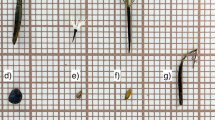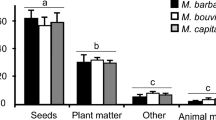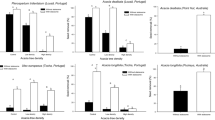Summary
Of 36 plant species surveyed, 6 were significantly associated with nests of the desert seed-harvester ant Veromessor pergandei or Pogonomyrmex rugosus; two other plant species were significantly absent from ant nests. Seeds of two common desert annuals, Schismus arabicus and Plantago insularis, realize a 15.6 and 6.5 fold increase (respectively) in number of fruits or seeds produced per plant growing in ant nest refuse piles compared to nearby controls. Mass of individual S. arabicus seed produced by plants growing in refuse piles also increased significantly. Schismus arabicus, P. insularis and other plants associated with ant nests do not have seeds with obvious appendages attractive to ants. Dispersal and reproductive increase of such seeds may represent a relatively primitive form of ant-plant dispersal devoid of seed morphological specializations. Alternatively, evolution of specialized seed structures for dispersal may be precluded by the assemblage of North American seed-harvester ants whose workers are significantly larger than those ants normally associated with elaiosome-attached seed dispersal. Large worker size may permit consumption of elaiosome and seed.
Similar content being viewed by others
References
Bell EA (1984) Toxic compounds in seeds. In: Murray DR (ed) Seed Physiology, Vol 1 Development. Academic Press, New York-London, pp 246–264
Berg RY (1975) Myrmecochorous plants in Australia and their dispersal by ants. Aust J Bot 23:475–508
Bernstein RA, Gobbel M (1979) Partitioning of space in communities of ants. J Anim Ecol 48:931–942
Bor NL (1960) The Grasses of Burma, Ceylon, India and Pakistan. Pergamon Press, Oxford
Brown JH (1975) Geographical ecology of desert rodents. In: Cody ML, Diamond JM (eds), Ecology and Evolution of Communities. Belknap Press of Harvard University Press, Cambridge, Massachusetts USA, pp 315–341
Brown JH, Reichman OJ, Davidson DW (1979) Granivory in desert ecosystems. Ann Rev Ecol Syst 10:201–227
Buckley RC (1982) Ant-plant interactions: a world review. In: Buckley RC (ed), Ant-plant Interactions in Australia. Dr W Junk, The Hague, pp 111–141
Cody ML (1974) Competition and the Structure of Bird Communities. Princeton University Press, Princeton
Cole AC (1932) The ant, Pogonomyrmex occidentalis, Cr., associated with plant communities. Ohio J Sci 32:10–20
Culver DC, Beattie AJ (1978) Myrmecochory in Viola: Dynamics of seed-ant interactions in some West Virginia species. J Ecol 66:53–72
Davidson DW (1977) Foraging ecology and community organization in desert seed-eating ants. Ecology 58:725–737
Davidson DW (1978) Size variability in the worker caste of a social insect (Veromessor pergandei Mayr) as a function of the competitive environment. Amer Nat 112:523–532
Davidson DW, Morton SR (1981) Myrmecochory in some plants (F. Chenopodiaceae) of the Australian arid zone. Oecologia (Berlin) 50:357–366
Dlusskii GM Saparlyev K (1975) The dynamics of activity in desert harvester ants. Ekologiya 6:79–85
Gilbert LE (1979) Development of theory in the analysis of insect-plant relationships. In: Horn DJ, Stairs GR, Mitchell RD (eds) Analysis of Ecological Systems. Ohio State University Press, Columbus, pp 117–154
Golley FB, Gentry JB (1964) Bioenergetics of the southern harvester ant Pogonomyrmex badius. Ecology 45:217–225
Harper JL (1977) Population Biology of Plants. Academic Press, New York-London
Heinrich B (1976) Foraging specializations of individual bumblebees. Ecol Monog 46:105–128
Heinrich B (1979) “Majoring” and “minoring” by foraging bumblebees, Bombus vagans: an experimental analysis. Ecology 60:245–255
Heithaus ER (1981) Seed predation by rodents on three ant-dispersed plants. Ecology 62:136–145
Hitchcock AS (1971) Manual of Grasses of the United States. Vol 1. Dover, NY
Inouye RS (1980) Density-dependent germination response by seeds of desert annuals. Oecologia (Berlin) 46:235–238
Kearney TH, Peebles RH, and collaborators (1951) Arizona Flora. University of California Press
Kusnezov NN (1956) A comparative study of ants in desert regions of central Asia and South America. Am Nat 90:349–360
Milewski AV, Bond WJ (1982) Convergence of myrmecochory in mediterranean Australia and South Africa. In: Buckley RC (ed) Ant-plant interactions in Australia, Dr W Junk Publishers, The Hague, pp 89–98
Moore LR (1978) Seed predation in the legume Crotalaria. II: Correlates of interplant variability in predation intensity. Oecologia (Berlin) 34:203–223
Morton SR (1982) Granivory in the Australian arid zone: diversity of harvester ants and the structure of their communities. In: Barker W, Greenslade J (eds), Evolution of the Flora and Fauna of Arid Australia. Peacock, Adelaide, pp 257–262
O'Dowd DJ, Hay ME (1980) Mutualisms between harvester ants and a desert ephemeral: seed escape from rodents. Ecology 61:531–540
Pisarski B (1978) Comparison of various biomes. In: Brian ME (ed), Production Ecology of Ants and Termites. Cambridge University Press, Cambridge, pp 326–331
Platt WJ, Weis IM (1977) Resource partitioning and competition within a guild of fugitive prairie plants. Am Nat 111:479–513
Plowright RC, Hartling LK (1981) Red clover pollination by bumble bees: a study of the dynamics of a plant-pollinator relationship. J Ap Ecol 18:639–647
Rabinowitz D, Rapp JK (1981) Dispersal abilities of seven sparse and common grasses from a Missouri prairie. Amer J Bot 68:616–624
Reichman OJ (1975) Relationships between dimensions, weights, volumes, and calories of some Sonoran Desert seeds. Southwest Natur 20:573–575
Rissing SW (1981) Foraging specializations of individual seed-harvester ants. Behav Ecol Sociobiol 9:149–152
Sokal RR, Rohlf FJ (1981) Biometry, Second ed. WH Freeman, San Francisco
Thompson PA (1981) Variations in seed size within populations of Silene dioica (L.) Clairv. in relation to habitat. Ann Bot 47:623–634
Weis IM (1982) The effects of propagule size on germination and seedling growth in Mirabilis hirsuita. Can J Bot 60:1868–1874
Westoby M, Rice B, Shelley JM, Haig D, Kohen JL (1982) Plants' use of ants for dispersal at West Head, New South Wales. In: Buckley (ed) Ant-plant Interactions in Australia. Dr W Junk Publishers, The Hague pp 75–87
Wheeler J, Rissing SW (1975) Natural history of Veromessor pergandei. I. The nest. Pan-Pacific Entomol 51:205–216
Wight JR, Nichols JT (1966) Effects of harvester ants on production of saltbush community. J Range Manage 19:68–71
Author information
Authors and Affiliations
Rights and permissions
About this article
Cite this article
Rissing, S.W. Indirect effects of granivory by harvester ants: plant species composition and reproductive increase near ant nests. Oecologia 68, 231–234 (1986). https://doi.org/10.1007/BF00384792
Received:
Issue Date:
DOI: https://doi.org/10.1007/BF00384792




